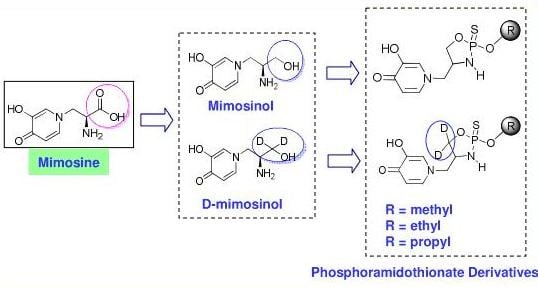Insecticidal and Nematicidal Activities of Novel Mimosine Derivatives
Abstract
:1. Introduction
2. Results and Discussion
2.1. Synthesis
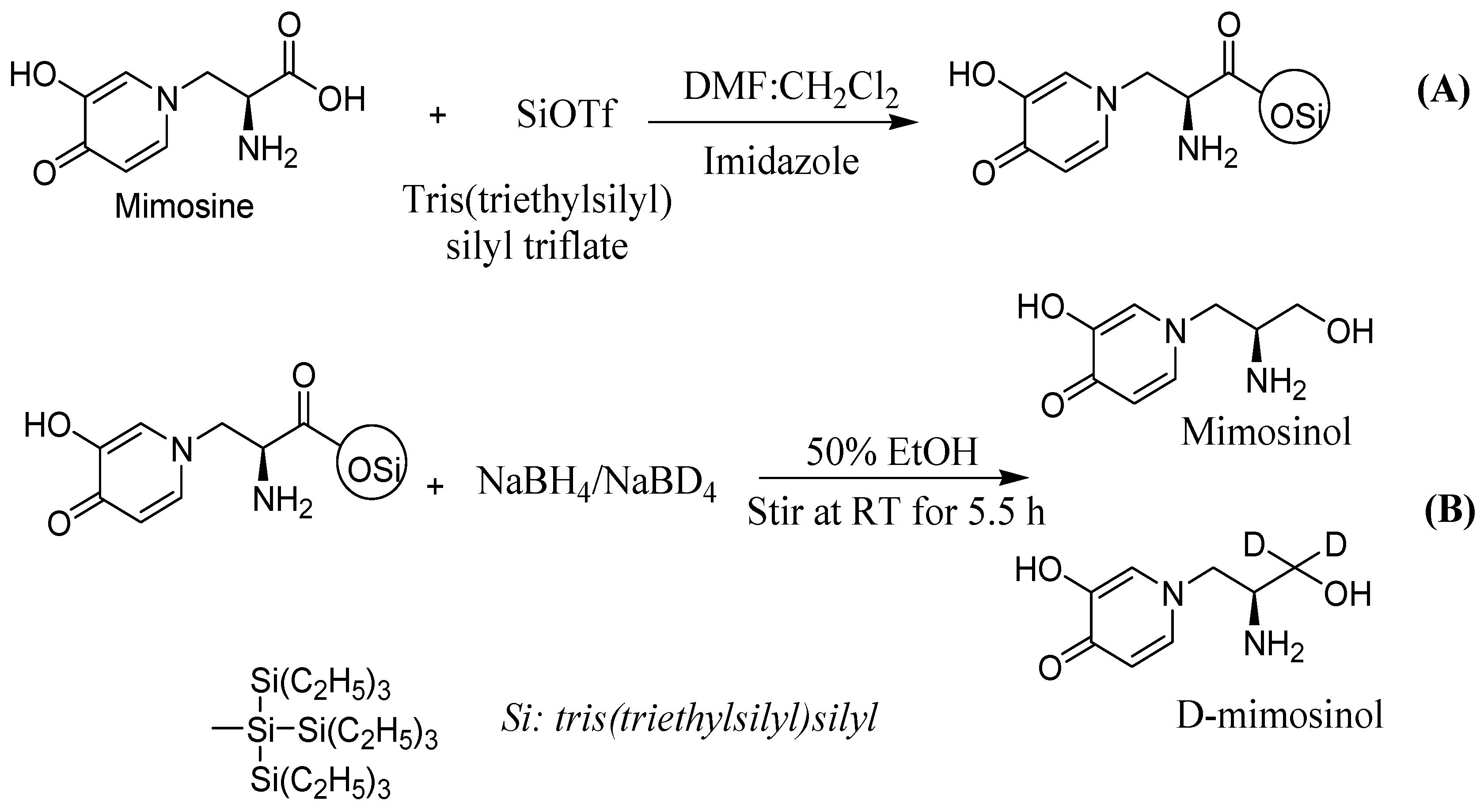
2.2. Insecticidal Activity
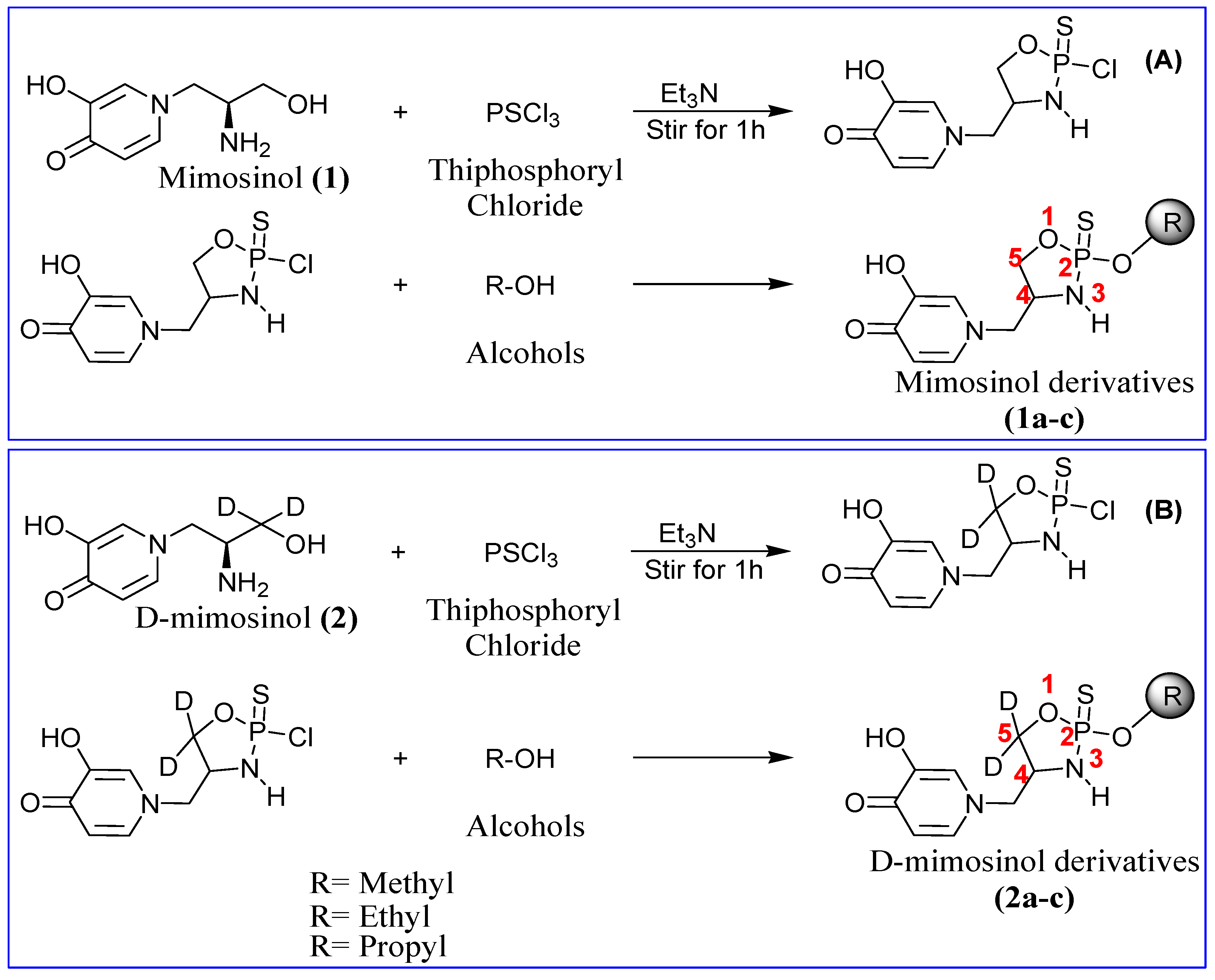
| Compound | LD50 (μg/insect) i |
|---|---|
| Mimosinol | 1.2 ± 0.2 de |
| 1a | 0.5 ± 0.1 fg |
| 1b | 0.7 ± 0.1 ef |
| 1c | 0.8 ± 0.1 ef |
| d-mimosinol | 1.8 ± 0.3 d |
| 2a | 1.2 ± 0.2 de |
| 2b | 2.1 ± 0.4 c |
| 2c | 3.1 ± 0.5 b |
| Mimosine | 54.1 ± 5.9 a |
| Rotenone | 0.8 ± 0.2 ef |
| Fenitrothion | 0.025 ± 0.0 g |
| Compound | Mortality (%) | ||
|---|---|---|---|
| 250 μg/mL ii | 100 μg/mL | 50 μg/mL | |
| Mimosinol | 68.5 ± 0.6 c | 52.5 ± 2.7 de | 38.1 ± 1.3 cde |
| 1a | 90.6 ± 1.3 a | 88.8 ± 0.9 a | 62.5 ± 1.8 a |
| 1b | 84.4 ± 2.2 ab | 71.9 ± 1.3 b | 52.5 ± 3.5 ab |
| 1c | 77.5 ± 0.9 b | 59.4 ± 1.3 cd | 45.6 ± 0.4 bc |
| d-mimosinol | 60.6 ± 0.6 cd | 53.8 ± 3.8 de | 33.1 ± 1.9 de |
| 2a | 82.5 ± 1.3 ab | 70.6 ± 0.6 b | 48.8 ± 2.5 bc |
| 2b | 63.8 ± 0.0 c | 52.5 ± 2.5 de | 42.5 ± 2.5 bcd |
| 2c | 52.5 ± 3.8 d | 44.4 ± 1.9 e | 29.4 ± 1.9 e |
| Mimosine | 9.1 ± 2.0 e | 7.5 ± 1.0 f | 2.5 ± 1.1 f |
| Rotenone | 80.0 ± 0.9 b | 68.1 ± 1.3 bc | 48.8 ± 0.9 bc |
| Compound | Mortality (%) | ||
| 15 μg/mL | 10 μg/mL | 5 μg/mL | |
| Fenitrothion | 83.8 ± 1.9 | 69.4 ± 0.6 | 26.9 ± 1.3 |
2.3. Tyrosinase and AChE Inhibition
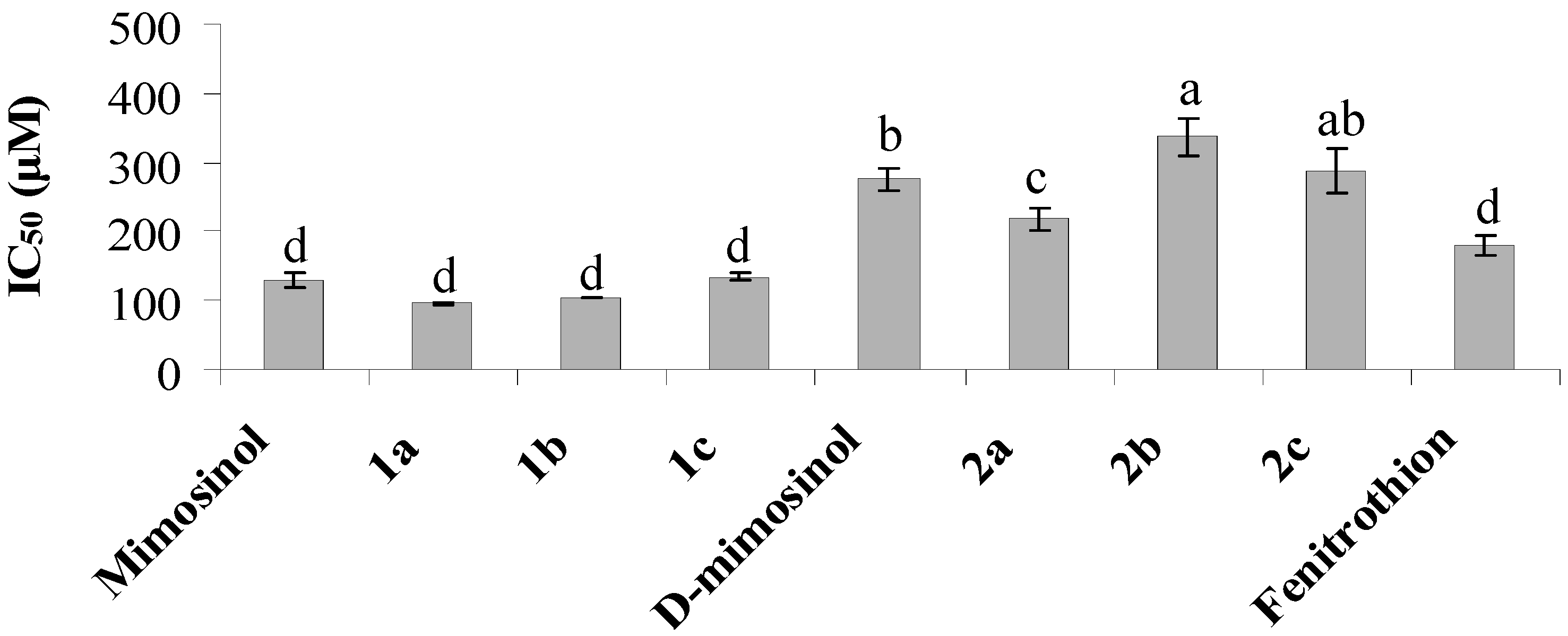

2.4. Nematicidal Activity of Mimosine Derivatives
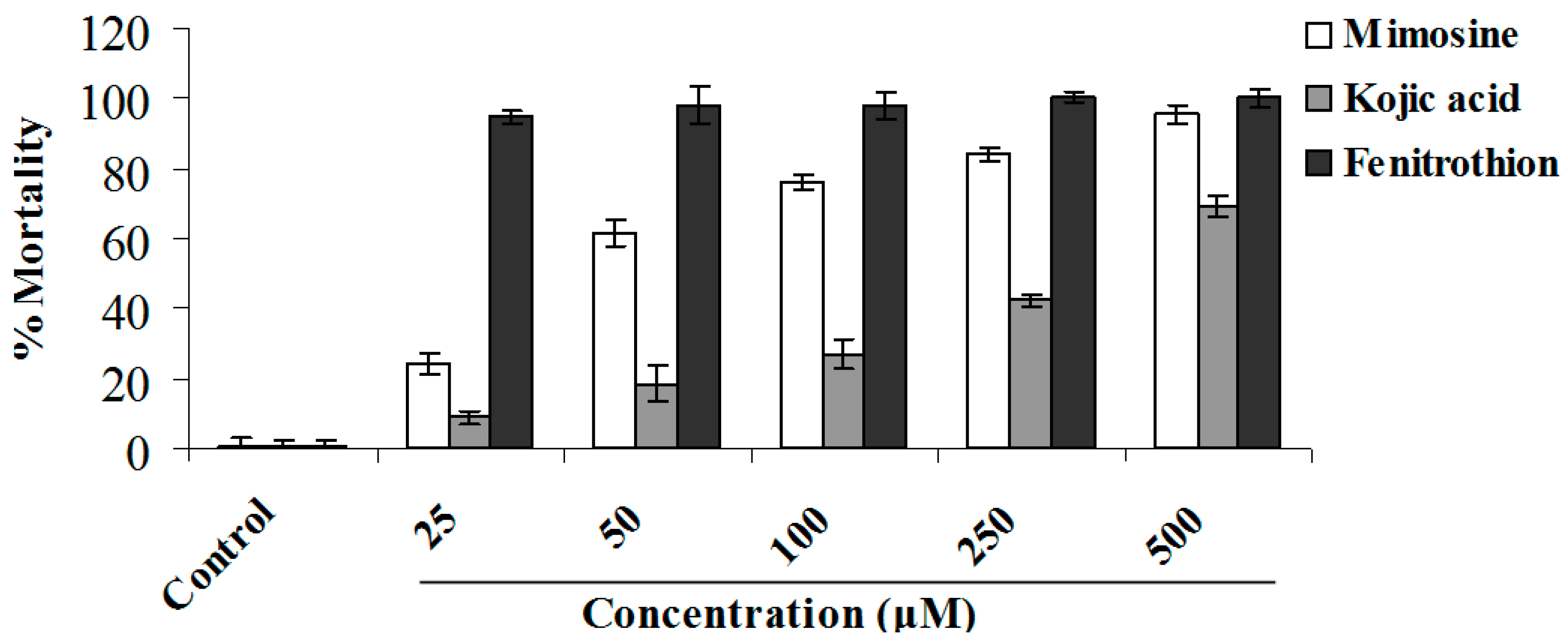

2.5. Discussion
3. Experimental Section
3.1. Chemicals and Reagents
3.2. Mimosine Isolation from Leucaena leucocephala Leaves
3.3. Synthesis of Mimosinol and Deuterated Mimosinol
3.4. General Procedure for Synthesis of Mimosinol (1a–c) Derivatives
3.5. General Procedure for Synthesis of Deuterated Mimosinol (2a–c) Derivatives
3.6. Topical Assay against Termites
3.7. No-Choice Assay against Termites
3.8. Nematicidal Activity Assay against Caenorhabditis Elegans
3.9. Assay for Acetylcholinesterase (AChE) Inhibition
3.10. Tyrosinase Inhibition Assay
3.11. Data Analysis
4. Conclusions
Acknowledgments
Author Contributions
Conflicts of Interest
References and Notes
- Güngördü, A.; Sireci, N.; Kücükbay, H.; Birhanli, A.; Ozmen, M. Evaluation of in vitro and in vivo toxic effects of newly synthesized benzimidazole-based organophosphorus compounds. Ecotoxicol. Environ. Saf. 2013, 87, 23–32. [Google Scholar] [CrossRef] [PubMed]
- Pandey, V.K.; Dwivedi, A.; Pandey, O.P.; Sengupta, S.K. Organophosphorus derivatives containing isatin-3-hydrazones as chemotherapeutants against fungal pathogens of sugarcane. J. Agric. Food Chem. 2008, 56, 10779–10784. [Google Scholar] [CrossRef] [PubMed]
- Jaiswal, A.K.; Rao, G.P.; Pandey, O.P.; Sengupta, S.K. Efficacy of organophosphorus derivatives against fungal pathogens of sugarcane. J. Agric. Food Chem. 1998, 46, 1609–1613. [Google Scholar] [CrossRef]
- Chandra, R.; Pandey, O.P.; Sengupta, S.K. Organophosphorus derivatives containing piperazine dithiosemicarbazones as chemotherapeutants against fungal pathogens of sugarcane. J. Agric. Food Chem. 2005, 53, 2181–2184. [Google Scholar] [CrossRef] [PubMed]
- Kolosova, A.Y.; Park, J.H.; Eremin, S.A.; Kang, S.J.; Chung, D.H. Fluorescence polarization immunoassay based on a monoclonal antibody for the detection of the organophosphorus pesticide parathion-methyl. J. Agric. Food Chem. 2003, 51, 1107–1114. [Google Scholar] [CrossRef] [PubMed]
- Carvalho, R.A.; Omoto, C.; Field, L.M.; Williamson, M.S.; Bass, C. Investigating the molecular mechanisms of organophosphate and pyrethroid resistance in the fall armyworm Spodoptera frugiperda. PLoS ONE 2013, 8. [Google Scholar] [CrossRef] [PubMed] [Green Version]
- Lu, Y.; Park, Y.; Gao, X.; Zhang, X.; Yao, J.; Pang, Y.P.; Jiang, H.; Zhu, K.Y. Cholinergic and non-cholinergic functions of two acetylcholinesterase genes revealed by gene-silencing in Tribolium castaneum. Sci. Rep. 2012, 2. [Google Scholar] [CrossRef] [PubMed]
- Pan, Z.Z.; Li, H.L.; Yu, X.J.; Zuo, Q.X.; Zheng, G.X.; Shi, Y.; Liu, X.; Lin, Y.M.; Liang, G.; Wang, Q.; et al. Synthesis and antityrosinase activities of alkyl 3,4-dihydroxybenzoates. J. Agric. Food Chem. 2011, 59, 6645–6649. [Google Scholar] [CrossRef] [PubMed]
- Tawata, S.; Fukuta, M.; Xuan, T.D.; Deba, F. Total utilization of tropical plants Leucaena leucocephala and Alpinia zerumbet. J. Pestic. Sci. 2008, 33, 40–43. [Google Scholar] [CrossRef]
- Dai, Y.; Gold, B.; Vishwanatha, J.K.; Rhode, S.L. Mimosine inhibits viral DNA synthesis through ribonucleotide reductase. Virology 1994, 205, 210–216. [Google Scholar] [CrossRef] [PubMed]
- Conti, P.; Frydas, S.; Reale, M.; Barbacane, R.C.; Gioacchino, M.D.; Felaco, M.; Trakatellis, A. Inhibition of MCP-1 and MIP-2 transcription and translation by mimosine in muscle tissue infected with the parasite Trichinella spiralis. Mol. Cell. Biochem. 2002, 229, 129–137. [Google Scholar] [CrossRef] [PubMed]
- Chang, H.C.; Lee, T.H.; Chuang, L.Y.; Yen, M.H.; Hung, W.C. Inhibitory effect of mimosine on proliferation of human lung cancer cells is mediated by multiple mechanisms. Cancer Lett. 1999, 145, 1–8. [Google Scholar] [CrossRef]
- Tawata, S. Effective reduction and extraction of mimosine from L. leucocephala and the potential for its use as a lead compound of herbicides. In Pesticide and Alternatives; Casida, J.E., Ed.; Elsevier Science Publishers: Amsterdam, The Netherland, 1990; pp. 541–544. [Google Scholar]
- Ishaaya, I.; Hirashima, A.; Yablonski, S.; Tawata, S.; Eto, M. Mimosine, a nonprotein amino acid, inhibits growth and enzyme systems in Tribolium castaneum. Pestic. Biochem. Physiol. 1991, 39, 35–42. [Google Scholar] [CrossRef]
- Hirashima, A.; Ueno, R.; Eto, M. Effects of various stressors on larval growth and whole-body octopamine levels of Tribolium castaneum. Pestic. Biochem. Physiol. 1992, 44, 217–225. [Google Scholar] [CrossRef]
- Tawata, S.; Eto, M.; Ishiguro, T. Synthesis and insecticidal activities of five-membered cyclic phosphoramidates and phosphoramidothiolates. J. Pestic. Sci. 1978, 3, 257–266. [Google Scholar] [CrossRef]
- Eto, M.; Tawata, S.; Sakamoto, K.; Oshima, K. Novel insecticidal five-membered cyclic phosphoramidothionates derived from l-amino acids. J. Pestic. Sci. 1978, 3, 161–163. [Google Scholar] [CrossRef]
- Verma, M.; Sharma, S.; Prasad, R. Biological alternatives for termite control: A review. Int. Biodeterior. Biodegrad. 2009, 63, 959–972. [Google Scholar] [CrossRef]
- Rajashekar, Y.; Raghavendra, A.; Bakthavatsalam, N. Acetylcholinesterase inhibition by biofumigant (Coumaran) from leaves of Lantana camara in stored grain and household insect pests. Biomed. Res. Int. 2014, 2014. [Google Scholar] [CrossRef] [PubMed]
- Bai, P.P.; Chen, E.H.; Shen, G.M.; Wei, D.; Wei, D.D.; Wang, J.J. Inhibition of phenoloxidase activity delays development in Bactrocera dorsalis (Diptera: Tephritidae). Fla. Entomol. 2014, 97, 477–485. [Google Scholar] [CrossRef]
- Tawata, S.; Kuwano, E.; Eto, M. Synthesis and chemical properties of insecticidal 2-alkoxy-4-alkyl-1,3,2-oxazaphospholidine 2-sulfides derived from optically active amino acids. Agric. Biol. Chem. 1980, 44, 1489–1498. [Google Scholar] [CrossRef]
- Nguyen, B.C.Q.; Taira, N.; Tawata, S. Several herbal compounds in Okinawa plants directly inhibit the oncogenic/aging kinase PAK1. Drug Discov. Ther. 2014, 8, 238–244. [Google Scholar] [CrossRef] [PubMed]
- Tawata, S.; Taira, S.; Kobamoto, N.; Ishihara, M.; Toyama, S. Syntheses and biological activities of dihydro-5,6-dehydrokawain derivatives. Biosci. Biotechnol. Biochem. 1996, 60, 1643–1645. [Google Scholar] [CrossRef] [PubMed]
- Jang, S.H.; Park, Y.; Park, S.C.; Kim, P.I.; Lee, D.G.; Hahm, K.S. Antinematodal activity and the mechanism of the antimicrobial peptide, HP (2-20), against Caenorhabditis elegans. Biotechnol. Lett. 2004, 26, 287–291. [Google Scholar] [CrossRef] [PubMed]
- Solis, G.M.; Petrascheck, M. Measuring Caenorhabditis elegans life span in 96 well microtiter plates. J. Vis. Exp. 2011, 49. [Google Scholar] [CrossRef] [PubMed]
- Siramon, P.; Ohtani, Y.; Ichiura, H. Biological performance of Eucalyptus camaldulensis leaf oils from Thailand against the subterranean termite Coptotermes formosanus Shiraki. J. Wood Sci. 2009, 55, 41–46. [Google Scholar] [CrossRef]
- Yeom, H.J.; Kang, J.S.; Kim, G.H.; Park, I.K. Insecticidal and acetylcholine esterase inhibition activity of Apiaceae plant essential oils and their constituents against adults of German cockroach (Blattella germanica). J. Agric. Food Chem. 2012, 60, 7194–7203. [Google Scholar] [CrossRef] [PubMed]
- Tadtong, S.; Viriyaroj, A.; Vorarat, S.; Nimkulrat, S.; Suksamrarn, S. Antityrosinase and antibacterial activities of mangosteen pericarp extract. J. Health Res. 2009, 23, 99–102. [Google Scholar]
- Sample Availability: Samples of the title compounds, mimosine and compounds 1a, 1b, 1c, are available from the authors.
© 2015 by the authors. Licensee MDPI, Basel, Switzerland. This article is an open access article distributed under the terms and conditions of the Creative Commons Attribution license ( http://creativecommons.org/licenses/by/4.0/).
Share and Cite
Nguyen, B.C.Q.; Chompoo, J.; Tawata, S. Insecticidal and Nematicidal Activities of Novel Mimosine Derivatives. Molecules 2015, 20, 16741-16756. https://doi.org/10.3390/molecules200916741
Nguyen BCQ, Chompoo J, Tawata S. Insecticidal and Nematicidal Activities of Novel Mimosine Derivatives. Molecules. 2015; 20(9):16741-16756. https://doi.org/10.3390/molecules200916741
Chicago/Turabian StyleNguyen, Binh Cao Quan, Jamnian Chompoo, and Shinkichi Tawata. 2015. "Insecticidal and Nematicidal Activities of Novel Mimosine Derivatives" Molecules 20, no. 9: 16741-16756. https://doi.org/10.3390/molecules200916741




